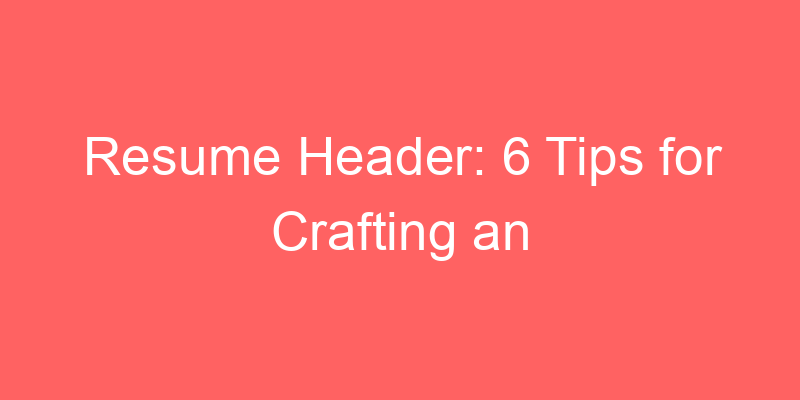Header on Resume: Yes or No? The Ultimate Guide
A well-crafted resume is your key** to unlocking exciting career opportunities. Crafting a resume** can involve many questions, and one of the most common is header on resume: yes or no? The answer, like most things in life, is it depends**.
This article will explore the pros and cons** of including a header on resume**, and provide guidance** on when it might be necessary**.
Yes to a Header on Resume?
A header on resume** can be a valuable tool** to clearly display your contact information**. Here’s why you might include a header**:
Enhanced Readability: A header** separates your contact information from the rest of your resume content, making it easy for potential employers** to find you.
Professional Presentation: A well-formatted header** creates a polished and professional first impression**.
Limited Space: If your resume content is concise**, a header** can effectively utilize white space** at the top of the page.
Here’s what a typical header on resume** might include:
- Your Full Name
- Phone Number
- Email Address
- (Optional) LinkedIn Profile Link
Example of a Resume Header:
John Doe
[Phone Number] | [Email Address] | [LinkedIn Profile Link]
No Header on Resume? Consider These Reasons
While headers on resumes** offer advantages, there are situations where they might be unnecessary. Here’s why you might skip the header**:
Modern Resume Template: Some modern resume templates incorporate your contact information** within the resume design**, eliminating the need for a separate header.
Applicant Tracking Systems (ATS): Applicant tracking systems** often extract contact information** from the body of your resume. Including it twice (in the header and body) could be redundant.
Limited Use of Space: If your resume requires multiple pages**, it’s crucial to maximize space** for your experience and skills. In this case, a header** might be a luxury you can’t afford**.
The Final Verdict on Headers on Resumes**
Ultimately, the decision to include a header on resume** is a personal choice. Consider the factors mentioned above** and make the best decision for your specific situation**. Here’s a quick tip:
- When in doubt, include a header. A clear and professional header** never hurts**.
Remember: A strong resume goes beyond the presence or absence of a header. Focus on creating compelling content** that showcases your qualifications and achievements**.
Yes, Include a Resume Header for a Professional First Impression
A well-crafted resume header is essential real estate at the top of your resume. It acts as a mini billboard, grabbing the attention of hiring managers and recruiters in those crucial first few seconds. So, should you include a resume header? Absolutely! Here’s why a resume header is a must-have and how to create an effective one.
Example 1: The Essential Elements
A strong resume header includes key contact and branding information.
- Contact information: List your full name, professional email address, and phone number (optional). Ensure your email address is professional and avoids cutesy nicknames or outdated references.
- Location (optional): Including your city and state can be relevant depending on the job market and your willingness to relocate.
- Professional title (optional): Consider including your current job title or a title that summarizes your career goals.
Example Text: Imagine you’re a marketing professional with a strong online presence. Your resume header should prominently feature your full name, a professional email address like “[email address removed],” and a link to your professional website or LinkedIn profile. Including your city and state can demonstrate your availability in a specific location, if relevant. If you’re targeting marketing manager positions, you could consider adding “Marketing Manager” as your professional title.
Example 2: The Creative Touch (use sparingly)
A resume header can subtly showcase your personal brand (use with caution).
- A touch of color: A subtle pop of color can make your resume header stand out, but use it sparingly and ensure it aligns with the company’s branding for a cohesive look.
- A professional headshot (optional): A professional headshot can add a personal touch, but ensure it’s high-quality and adheres to professional standards.
Example Text: Let’s say you’re a graphic designer applying for creative design roles. Your resume header could incorporate a subtle design element that reflects your style, but ensure it remains professional and doesn’t overwhelm the content. If you have a polished headshot that showcases your professionalism, you could consider including it, but prioritize clear and concise contact information.
Conclusion
A well-crafted resume header is like a handshake at the beginning of an interview. It introduces you professionally and sets the tone for the rest of your resume. By including the essential contact information and considering a touch of creative branding, you can craft a resume header that makes a positive first impression and helps you land that dream job.
Generate Your NEXT Resume with AI
Accelerate your resume crafting with the AI Resume Builder. Create personalized resume summaries in seconds.




